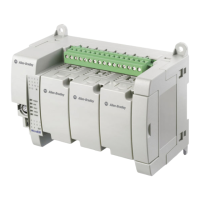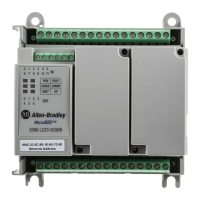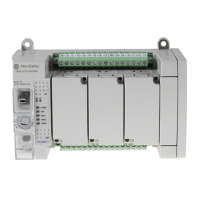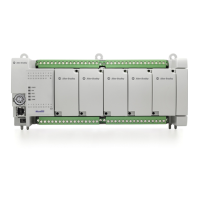Publication 1763-UM001E-EN-P - June 2015
16 Hardware Overview
Programming
Programming the MicroLogix 1100 controller is done using RSLogix 500,
Revision 7.0 or later. To use all of the latest features, RSLogix 500
programming software must be version 7.20.00 or later. Communication
cables for programming are available separately from the controller and
software.
Communication Options
The MicroLogix 1100 controllers provide two communications ports, an
isolated combination RS-232/485 communication port (Channel 0) and an
Ethernet port (Channel 1).
The isolated Channel 0 port on the MicroLogix 1100 can be connected to the
following:
• operator interfaces, personal computers, etc. using DF1 Full Duplex
point-to-point
• a DH-485 network
• a DF1 Radio Modem network
• a DF1 half-duplex network as an RTU Master or RTU Slave
• a Modbus network as an RTU Master or RTU Slave
• an ASCII network
• an Ethernet network using the Ethernet Interface module (catalog
number 1761-NET-ENI, or 1761-NET-ENIW)
When connecting to a DH-485 network, DF1 half-duplex network
(1)
or a
Modbus network, the MicroLogix 1100 can be connected directly via Channel
0 (without an Advanced Interface Converter, catalog number 1761-NET-AIC).
The Channel 0 combo port provides both RS-232 and RS-485 isolated
connections. The appropriate electrical interface is selected through your
choice of communication cable. The existing MicroLogix 1761
communication cables provide an interface to the RS-232 drivers. The
1763-NC01 cable provides an interface to the RS-485 drivers (for DH-485,
Modbus RTU Master, RTU slave networks, DF1 half-duplex Master
(1)
and
DF1 half-duplex Slave
(1)
).
The controller may also be connected to serial devices, such as bar code
readers, weigh scales, serial printers, and other intelligent devices, using ASCII.
See Default Communication Configuration on page 72 for the configuration
settings for Channel 0. MicroLogix 1100 can be connected directly to RS-485
network via channel 0, using ASCII
(1)
.)
The MicroLogix 1100 supports Ethernet communication via the Ethernet
communication Channel 1. You can connect your controller to a local area
network that provides communication between various devices at 10 Mbps or
100 Mbps. This port supports CIP explicit messaging (message exchange) only.
(1)
OS Series B FRN4 or later.

